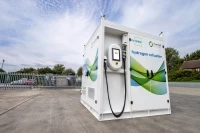- What is a dual pressure hydrogen filling station?
- How do dual pressure hydrogen refueling stations work?
- Which are the main pressure combinations for such hydrogen stations (350 bar and 700 bar)?
- What is the main difference to a normal hydrogen refueling station?
- Which additional components are needed for a dual pressure hydrogen refueling station?
- What are the advantages of a dual pressure hydrogen filling station?
- Are there any disadvantages (e.g. additional CAPEX)?
- Which are the typical use cases of dual pressure hydrogen stations?
- How much service station space is occupied by a dual pressure hydrogen refueling station?
- Is it possible to have more than one dispenser available at the filling station?
- What are key performance criteria of a dual pressure filling station for hydrogen?
- Which aspects shall be considered in the sizing of such stations?
- Is hydrogen stored at one place of the filling station and then compressed differently?
- Are modern dual pressure hydrogen refueling stations less efficient because they need to operate a flexible pressure concept?
Browse all hydrogen refueling stations from leading suppliers on our marketplace!
What is a dual pressure hydrogen filling station?
A dual pressure hydrogen filling station is a hydrogen refueling station which enables the possibility to refuel both pressure levels (700 bar and 350 bar), for light (cars) and medium duty vehicles all the way up to heavy-duty vehicles (like buses, trains, aircraft and trucks). This establishes coverage for most of the currently available hydrogen mobility solutions.
How do dual pressure hydrogen refueling stations work?
In a dual pressure hydrogen refueling station, hydrogen is compressed in a similar way like a single pressure hydrogen filling station. Nowadays, the hydrogen is compressed to a pressure level above the target level and stored in high pressure storages. For refueling the hydrogen is refueled via cascaded transfill from the storage tanks to the vehicles. For 700 bar refueling the hydrogen is chilled down to -40°C. For 350 bar refueling the hydrogen is mostly not actively chilled.
Which are the main pressure combinations for such hydrogen stations (350 bar and 700 bar)?
The main pressure combinations for dual pressure refueling is 350 bar for medium to heavy duty vehicles and 700 bar for light duty vehicles. So up to 120 g/s for 350 bar and up to 50 kg per refueling and for 700 bar up to 60 g/s and up to 50 kg per refueling.
What is the main difference to a normal hydrogen refueling station?
The main difference between a normal hydrogen refueling station and a dual pressure refueling station is the ability to refuel both types of vehicles, rated at 350 bar (heavy-duty vehicles) and at 700 bar (medium and light-duty vehicles).
Which additional components are needed for a dual pressure hydrogen refueling station?
Compared to a single pressure hydrogen refueling station each pressure level has its own refueling point with a dedicated safety valve, pressure regulator, fueling valve, heat exchanger (if necessary), featuring a separate break-away coupling, hose, dispenser nozzle and display.
What are the advantages of a dual pressure hydrogen filling station?
The main advantage of a dual pressure hydrogen refueling station is the efficient use of space. Due to combining both pressure levels in one station the usage of the same equipment is leveraged for two refueling points, thereby decreasing the total cost of ownership.
Are there any disadvantages (e.g. additional CAPEX)?
Of course a filling station accommodating dual pressure dispensing will initially incur higher capital expenditure. However, due to the overall reduction of total cost of ownership by way of integrating multiple pressure levels into one station, the initial investment is subject to a higher rate of amortization.
Which are the typical use cases of dual pressure hydrogen stations?
Right now, nearly all stations in Switzerland are equipped for both pressure levels. 350 bar for refueling the trucks of Hyundai and 700 bar for refueling passenger cars. A typical use case of a dual pressure hydrogen refueling station is an installation at a service area serving light- and medium-/heavy-duty vehicles, such as logistics hubs where 700 bar vehicles like vans and also 350 bar vehicles like trucks regularly arrive for refueling.
Another use case is the hydrogen refueling station at a provider of public transport which is running buses (350 bar) and is also offering a refueling point for taxis (700 bar), thereby offering coverage for hydrogen mobility solutions in all conceivable public transport applications.
How much service station space is occupied by a dual pressure hydrogen refueling station?
For example, the assemblies of Maximator Hydrogen stations are installed in standard containers and as such can be arranged freely. The core components are integrated in a 20 foot container. The footprint of the entire refueling station is approximately 25 m² and can require up to 100 m² of surface area.
Is it possible to have more than one dispenser available at the filling station?
Up to 4 fueling points with 2 dispensing nozzles each can now be installed on a modern dual pressure filling station.
What are key performance criteria of a dual pressure filling station for hydrogen?
The key performance criteria of dual pressure filling stations are the same as for a single pressure hydrogen filling station. Simultaneous or parallel filling is often the key performance characteristic.
Which aspects shall be considered in the sizing of such stations?
A handling area is required immediately in front of one side of the container. Besides this the housing can be adapted to fulfill higher standards for noise cancellation or fire protection. This can further assist in a reduction of the footprint for the customer.
Is hydrogen stored at one place of the filling station and then compressed differently?
Hydrogen compression for both pressure levels takes place using the same compressor and the compressed hydrogen fuel is stored in the same storage vessels. In the event of refueling the refueling process ends exactly at the required pressure level, this being either 350 bar, or 700 bar.
Are modern dual pressure hydrogen refueling stations less efficient because they need to operate a flexible pressure concept?
Especially for decentralized green hydrogen production using renewable energy sources, the actual use case and therefore required filling pressure will already be known and specified. However, when offering hydrogen refuelling to a variety of businesses and use cases, as well as to the public at large, the filling station must accommodate a flexible pressure concept so as to meet a variety of demand scenarios in real time. In preparation for the fuel transfer from filling station to vehicle, the fuel is then routed into a cascade storage or buffer storage to make the green hydrogen available at the optimum pressure needed for refuelling. In the case of hydrogen at 700 bar it is then run through a refrigeration unit to bring the fuel down to sub-minus temperatures. Only then is the hydrogen fuel routed to the dispenser. Some hydrogen refueling stations (HRS) incorporate different gas transfer pressurization applications in order to dispense liquid hydrogen or cryo-compressed hydrogen. The liquefied gas transfer pressurization thereby used entails longer refuelling times. But when using flexible pressure hydrogen refueling stations, the majority of FCEVs on the market today can be refuelled in a matter of only a few minutes. We therefore see no drawbacks in terms of efficiency when employing a flexible-pressure refueling concept accommodating several gas transfer modes.
Last update: 13.01.2023




